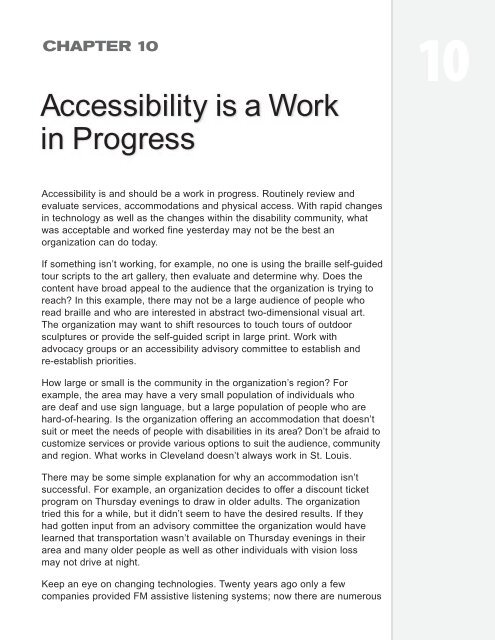Design for Accessibility: A Cultural Administrator's Handbook
Design for Accessibility: A Cultural Administrator's Handbook
Design for Accessibility: A Cultural Administrator's Handbook
Create successful ePaper yourself
Turn your PDF publications into a flip-book with our unique Google optimized e-Paper software.
CHAPTER 10<br />
<strong>Accessibility</strong> is a Work<br />
in Progress<br />
10<br />
<strong>Accessibility</strong> is and should be a work in progress. Routinely review and<br />
evaluate services, accommodations and physical access. With rapid changes<br />
in technology as well as the changes within the disability community, what<br />
was acceptable and worked fine yesterday may not be the best an<br />
organization can do today.<br />
If something isn’t working, <strong>for</strong> example, no one is using the braille self-guided<br />
tour scripts to the art gallery, then evaluate and determine why. Does the<br />
content have broad appeal to the audience that the organization is trying to<br />
reach? In this example, there may not be a large audience of people who<br />
read braille and who are interested in abstract two-dimensional visual art.<br />
The organization may want to shift resources to touch tours of outdoor<br />
sculptures or provide the self-guided script in large print. Work with<br />
advocacy groups or an accessibility advisory committee to establish and<br />
re-establish priorities.<br />
How large or small is the community in the organization’s region? For<br />
example, the area may have a very small population of individuals who<br />
are deaf and use sign language, but a large population of people who are<br />
hard-of-hearing. Is the organization offering an accommodation that doesn’t<br />
suit or meet the needs of people with disabilities in its area? Don’t be afraid to<br />
customize services or provide various options to suit the audience, community<br />
and region. What works in Cleveland doesn’t always work in St. Louis.<br />
There may be some simple explanation <strong>for</strong> why an accommodation isn’t<br />
successful. For example, an organization decides to offer a discount ticket<br />
program on Thursday evenings to draw in older adults. The organization<br />
tried this <strong>for</strong> a while, but it didn’t seem to have the desired results. If they<br />
had gotten input from an advisory committee the organization would have<br />
learned that transportation wasn’t available on Thursday evenings in their<br />
area and many older people as well as other individuals with vision loss<br />
may not drive at night.<br />
Keep an eye on changing technologies. Twenty years ago only a few<br />
companies provided FM assistive listening systems; now there are numerous


